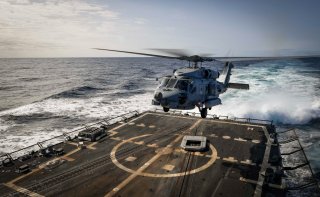Why China’s New AI Helicopter Program Looks Just Like America’s
A fundamental premise of artificial intelligence is easing the “cognitive burden” on pilots by performing high-volume, high-speed procedural and data processing functions autonomously.
China’s helicopter modernization plan appears to closely mirror or even copy several key aspects of the United States’ modernization efforts, particularly its focus on high-speed helicopters enabled with artificial intelligence (AI).
However, despite these clear ambitions, China may be several years behind the United States in some major areas, according to a report in the Global Times, a Chinese government-backed newspaper.
It may not be clear just how much progress China has made in developing AI systems, but the Global Times’ description of the functions and advantages of AI is quite similar to the way U.S. weapons developers talk about the subject.
A fundamental premise of AI, as described in recent years by U.S. weapons developers, is easing the “cognitive burden” on pilots by performing high-volume, high-speed procedural and data processing functions autonomously. This leverages the breakthrough speeds of AI-enabled processing and also frees up the human to consider more pressing or dynamic variables, such as mission-oriented decision-making. More subjective considerations and complex problem solving can be left to human cognition while computers perform complex comparisons and data analysis to inform human decisionmakers. This concept has long informed rapid U.S. technological and weapons development, and it may indeed have been noticed by the Chinese. The Global Times’ description of AI functionality almost exactly parallels how it is discussed in the United States.
Citing the engineer who designed the Chinese Z-10 helicopter, the report says that by using AI, “a digital helmet or screen could replace the control levers on a helicopter, as AI could understand voice commands from the pilot, give suggestions on flight routes, or even make independent decisions under harsh environments or in complex missions. … Intelligent technologies will greatly reduce the workload of the pilot.”
Using AI to “greatly reduce the workload of the pilot” is exactly how American weapons developers think about the potential impact of AI on future operations.
The Pentagon’s Future Vertical Lift program, for example, uses a human-machine interface to optimize the best blend of human cognition and subjective decision-making with high-speed computing. One such effort uses sensors, AI-enabled mapping, and navigational information to autonomously navigate the aircraft away from obstacles or potential collisions.
Kris Osborn is the Defense Editor for the National Interest. Osborn previously served at the Pentagon as a Highly Qualified Expert with the Office of the Assistant Secretary of the Army—Acquisition, Logistics & Technology. Osborn has also worked as an anchor and on-air military specialist at national TV networks. He has appeared as a guest military expert on Fox News, MSNBC, The Military Channel, and The History Channel. He also has a Master’s Degree in Comparative Literature from Columbia University.
Image: Flickr/U.S. Navy.

